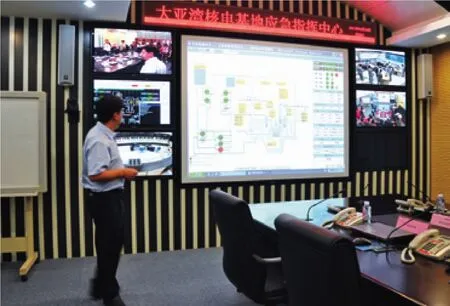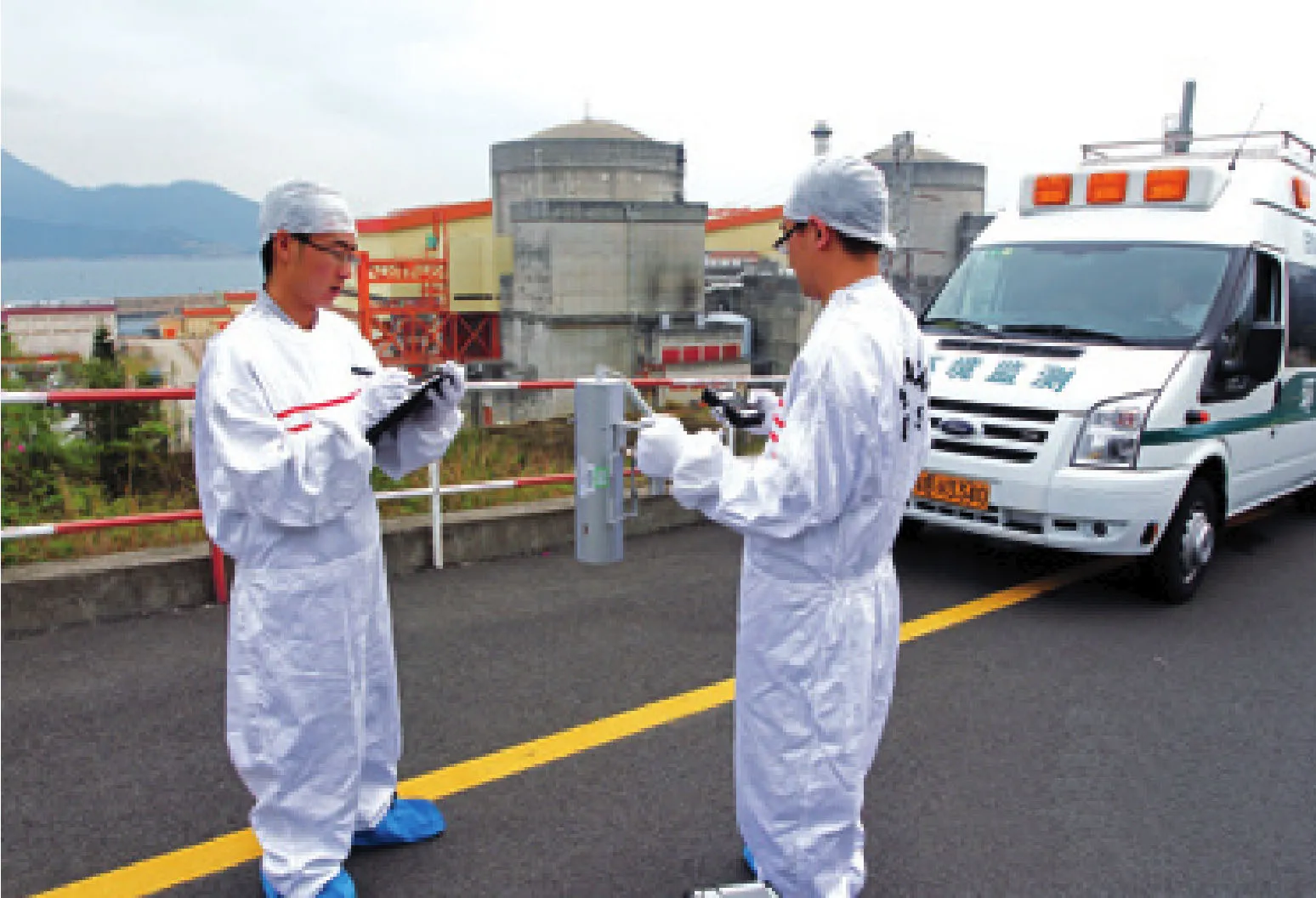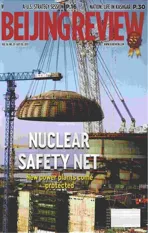SAFETY FIRST
2013-12-07ByYuShujun
By Yu Shujun
Summer is the busy season for the Dayawan nuclear power plant, located on the scenic Daya Bay in the south China city of Shenzhen. Not only is there a peak demand for electricity, but the typhoon season also means the plant must be ready to handle any emergency.
“As long as there are potential threats,we’ll utilize our emergency response system to keep our nuclear power plants safe,” said Zhao Fuming, associate chief safety engineer of Dayawan Nuclear Power Operation and Management Co. The Dayawan plant has successfully fended off six typhoons since going into operation in 1994.
Japan’s Fukushima nuclear accident in March 2011, which brought China’s once thriving nuclear power industry to a grinding halt,has spurred a rise in the level of nuclear safety and emergency response in China.
China relaunched its nuclear power projects in October 2012, requiring that all new nuclear power plants meet the world’s highest safety standard.
Drawing on the global response to nuclear accidents, especially the Fukushima accident,China’s nuclear authority has also revised its national nuclear emergency plan from its 2005 edition.
The plan, approved by the State Council and released on June 30, specifies how national and provincial authorities and nuclear power operators should respond to nuclear emergencies and requires accurate information be published in a timely and transparent manner in the eventof an incident or accident, according to the National Nuclear Emergency Response Office.The plan also expands emergency response to accidents that may happen during the transportation of spent nuclear fuel or aerospace vehicles equipped with nuclear devices.
在采购肥料和其他农资产品时,农产品价格依然是主要考量因素。恰克·马格罗(Chuck Magro)在季度电话会议上表示,如果中美贸易战持续升级,农民更愿购买能够增加产量的肥料。据全球最大肥料和农场用品供应公司预计,到了秋季,化肥需求旺季也将到来,肥料价格会有显著上升。然而,中美贸易战也影响到农产品价格的走势,尤其是在农产品丰收过后,农民会更加密切关注农产品的价格行情。“如果没有积极的方案应来对眼下日趋激烈的贸易战,美国农民将有可能更加忧虑。”马格罗表示:“农民无法承受一年的经济损失,而这也正是我们所担忧的。”
“Nuclear safety is the lifeline of the nuclear power industry and the emergency response system is the last firewall to ensure safety,”said Ma Xingrui, vice Minister of Industry and Information Technology and Chairman of China Atomic Energy Authority (CAEA).
The basic tasks of nuclear emergency response are to effectively deal with possible accidents, to control, mitigate and eliminate human harm and property loss, and to protect public and environmental safety, said Ma.
Currently, China has 17 nuclear power generating units in operation, with a combined capacity of 14.76 million kilowatts (kw), nine of which are operated by China National Nuclear Corp. (CNNC) and eight by China General Nuclear Power Corp. (CGN). Another 28 nuclear generating units are under construction, with a total capacity of 28.3 million kw.
So far, China’s nuclear safety record is clean,with no incidents or accidents above level 2 of the International Nuclear and Radiological Event Scale (INES) having taken place. There are seven levels on the INES scale: three incident levels(1-3) and four accident levels (4-7). Events without safety significance are called “deviations”and are class ified below level 0. The Fukushima accident has been rated level 7.
“But we should be 100-percent prepared for the one-millionth-of-1-percent possibility[of nuclear accidents],” said Xu Ping, Deputy Director of the Department of Nuclear Emergency and Safety Regulation at CAEA.
Emergency preparedness
The Chinese Government has attached great importance to nuclear safety and emergency response since the country set up its nuclear power industry in the 1950s, said Ma.
China began construction of its first nuclear power station in 1985, and a national committee to deal with nuclear emergencies was set up by the State Council in 1991. Having gone through several rounds of government structural reforms over the past two decades, the committee has evolved to the current National Nuclear Emergency Coordination Committee,consisting of 24 ministries or departments under the State Council and the army.
Yao Bin, Director General of the Department of Nuclear Emergency and Safety Regulation at CAEA, said ministries and departments have joined in forming a comprehensive and wellcoordinated response framework. For instance,the Ministry of Environmental Protection (MEP)has built a nuclear and radioactive monitoring network and the National Health and Family Planning Commission has set up a nuclear medicine network.

At the local level, 16 provinces, autonomous regions and municipalities have established nuclear emergency response committees.Nuclear power plant operators also have their emergency response groups.
The CAEA has also allocated nearly 1 billion yuan ($163 million) to set up four national nuclear emergency technical support centers and six emergency response and rescue units. Ma said that CAEA is also going to build a national nuclear emergency response and rescue team.
China also has competent sea, land and air monitoring systems for emergencies, said Liu Senlin, vice President of the China Institute of Atomic Energy, with more than 60 car-borne emergency monitoring systems.
The country’s nuclear emergency system has successfully responded to major events,including the Fukushima nuclear accident in 2011 and North Korea’s nuclear test in February 2013, said Ma.
After the Fukushima accident, China’s nuclear power plants have all strengthened their emergency response capabilities. Both operators—CNNC and CGN—have increased the number of mobile emergency power generators and mobile pumps and have added antiflood mod ifications to their power plants.
CNNC vice General Manager Yang Changli said his company has upgraded its technology on several fronts and completed safety measures in the event of multiple accidents.
In 2012, CNNC conducted 280 drills, according to Yang, to test the effectiveness and feasibility of emergency action plans of all power plants and improve emergency response capabilities.
CGN has also made safety improvements.“We don’t mind rising operational costs caused by the investments in nuclear safety,” said CGN vice General Manager Tan Jiansheng.
Information disclosure
Nuclear safety has always been a common concern among the public, which has the right to know the state of operations of nuclear power plants.
The revised plan also highlights a standard procedure for releasing information in the event of a nuclear emergency, said Xu. Once a nuclear incident or accident occurs, accurate information must be released in a timely manner to both the public and the international community.
CGN has established a nuclear and radiation information platform, said Tan. When an event above INES level 0 occurs, the platform will publish the information within two working days or 72 hours during holidays.
The public can check the website of the Dayawan Nuclear Power Operation and Management Co. about the operation,safety, radiation protection and environmental monitoring of the plant, said Hu Guangyao,spokesman of the CGN, which operates the Dayawan plant. “For those events below INES level 0, we’ll also put them on our websites for the public to check.”
“As long as the public knows what’s goingon, they won’t panic,” said Hu.

STAYING ALERT: A staff member at Dayawan introduces how the power plant’s emergency center works
CGN’s Ningde and Hongyanhe plants set up the same information platform on April 15 and June 7, respectively, said Hu. All CGN’s nuclear power plants under construction will follow the practice.
“Information disclosure has been included into our inner supervisory and control system,which is very strict,” said Li Jing, director of safety and information department of CGN. Any malfunctions or errors should be recorded faithfully.Anyone who hides the information, whether a manager or a technician, will be severely punished, said Li.
Raising public awareness
The Fukushima nuclear accident has exacerbated people’s worries about nuclear safety.But China, the world’s largest energy consumer,must continue developing nuclear power. A clean form of energy, though, nuclear power only contributes a meager 1.7 percent to the country’s electricity consumption, according to the CAEA.
People fear nuclear power mainly because they don’t know enough about it, said Chai Guohan, chief engineer at the MEP’s Nuclear and Radiation Safety Center.
Nuclear power is safe and clean and emits little greenhouse gas. The amount of radiation of a nuclear power plant is much less than a coal-fired plant, said Pan Ziqiang, a veteran expert of nuclear radiation protection and currently Chairman of the Committee of Science and Technology at the CNNC.
To demystify nuclear power, “we often invite the public to visit our power plants in aneffort to disseminate knowledge about nuclear power,” said CGN vice General Manager Tan. In the past two years, CGN’s power plants received nearly 10,000 visitors. CGN has also held more than 60 lectures on nuclear power and nuclear safety. The company also uses microblogs to further communicate with the public.

ENVIRONMENTAL MONITORING:Staff members test the air around the Dayawan nuclear power facilities
Once a nuclear accident occurs, the biggest impact won’t be physical but mental, said Liu from the China Institute of Atomic Energy.
“Increasing nuclear knowledge among the public and communicating more with them is beneficial to the healthy development of the nuclear energy industry.” ■
